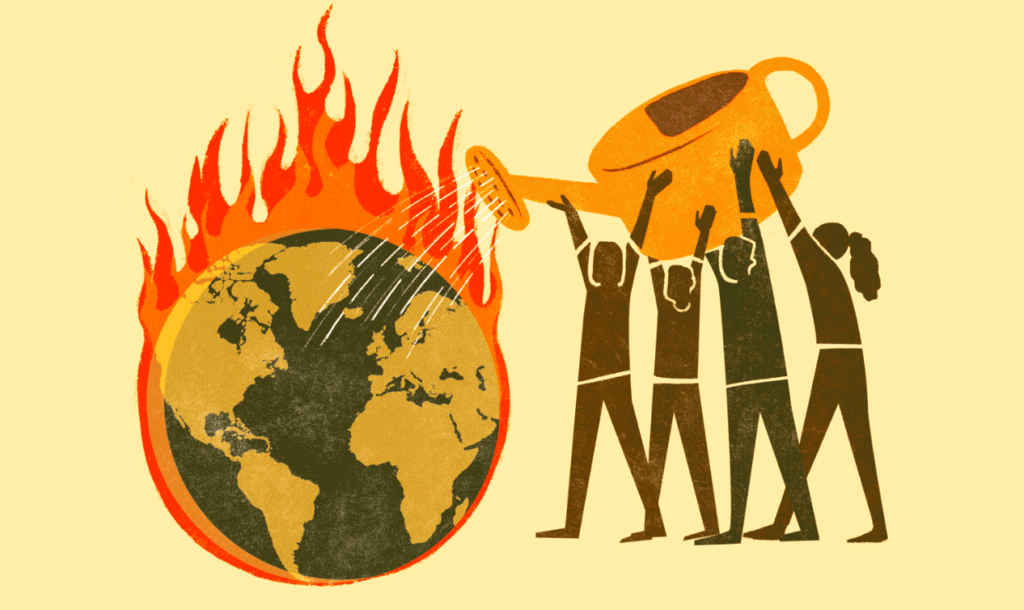Business as usual is what’s doing us in.
We live on a planet that finds itself rather suddenly in the midst of an enormous physical crisis. Because we burn so much coal and gas and oil, the atmosphere of our world is changing rapidly, and that atmospheric change is producing record heat. July was the hottest month we’ve ever recorded. Scientists predict with confidence that we stand on the edge of the sixth great extinction event of the last billion years. People are dying in large numbers and being left homeless; millions are already on the move because they have no choice.
And yet we continue on with our usual patterns. We get up each morning and do pretty much what we did the day before. It’s not like the last time we were in an existential crisis, when Americans signed up for the Army and crossed the Atlantic to face down fascism and when the people back home signed up for new jobs and changed their daily lives.
That’s why it’s such good news that the climate movement has a new tactic. Pioneered last August by Greta Thunberg of Sweden, it involves disrupting business as usual. It began, of course, in schools: Within months, millions of young people around the world were striking for days at a time from their classes. Their logic was impeccable: If the institutions of our planet can’t be bothered to prepare for a world we can live in, why must we spend years preparing ourselves? If you break the social contract, why are we bound by it?
And now those young people have asked the rest of us to join in. After the last great school strike in May, they asked adults to take part next time. The date is September 20, and the location is absolutely everywhere. Big trade unions in South Africa and Germany are telling workers to take the day off. Ben and Jerry’s is closing down its headquarters (stock up in advance), and if you want to buy Lush cosmetics, you’re going to be out of luck. The largest rally will likely be in New York City, where the U.N. General Assembly begins debating climate change that week—but there will be gatherings in every state and every country. It will almost certainly be the biggest day of climate action in the planet’s history. (If you want to be a part—and you do want to be a part—go to globalclimatestrike.net.)
It’s not a “strike” in the traditional sense, of course—no one is demanding better wages. But we are demanding better conditions. In the most literal sense, the world isn’t working as it should (studies say that increased heat and humidity have already reduced human work capacity as much as 10%, a figure that will double by midcentury). And what we’re saying is, disrupting business as usual is the way to get there.
This strike will not be the last such action. And activists are flooding into the electoral battles now underway and taking on the financial community, too. It’s starting to add up: The polling shows that for young Americans, climate change is far and away the most important issue.
But it can’t be just young people. It needs to be all of us—especially, perhaps, those of us who have been placidly operating on a business-as-usual basis for most of our lives, who have rarely faced truly serious disruptions in our careers and our plans. Our job is precisely to disrupt business as usual. When the planet leaves its comfort zone, we need to do the same. See you on the streets on Sept. 20!
(Bill McKibben is the Schumann Distinguished Scholar at Middlebury College and co-founder of 350.org.)
The Rise and Rise of the Global Climate Movement
I saw Greta Thunberg for the first time in Poland at the end of last year. It was during the early days of the Katowice UNclimate negotiations. She was sitting in a makeshift TV studio, having her pigtails re-tied. I was in a hurry, chasing too many stories down at once, and paid little attention to this 15-year-old girl.
Of course, I’d heard of Greta by that point. I’d received several emails inviting me to press conferences where she was speaking, but I hadn’t taken the bait.
I had recently written about the Juliana v United States litigation, where a group of young people sued the government for failing to protect them against climate change, and profiled the Zero Hour campaign led by 16-year-old Seattleite Jamie Margolin. I assumed Greta was the next star of climate youth activism. What I didn’t realise was that she would catalyse a shift in how climate activism works altogether.
Parliament
Climate activism isn’t new, but the last year has seen a resurgence in attention devoted to the subject. For many campaigners, who have grown weary of watching their warnings fall on deaf ears, it has felt like hope has arrived at last.
Greta’s rise to fame was swift.
Most people already know the story. She began striking outside the Swedish Parliament in August 2018, which garnered a certain amount of interest from journalists and fellow activists – in November, she gave a talk at TedxStockholm. But it was her explosive speech at the UN talks in Katowice that catapulted her into the limelight.
“We have not come here to beg world leaders to care. You have ignored us in the past and you will ignore us again,” she said. “We have run out of excuses and we are running out of time. We have come here to let you know that change is coming, whether you like it or not. The real power belongs to the people.”
At the same time as Greta was standing outside Parliament by herself, then without the eyes of the world on her, another group was travelling around the UK, testing the waters for another new movement. Between March and October 2018, they held around 60 discussions across the country. These events were called Heading for Extinction. Then, on the last day of October, the group declared a rebellion:
“Humanity finds itself embroiled in an event unprecedented in its history,” reads their Declaration. “We, in alignment with our consciences and our reasoning, declare ourselves in rebellion against our Government and the corrupted, inept institutions that threaten our future.”
In the following months, these two movements exploded into the mainstream. In April 2019, Extinction Rebellion forced London to a standstill with a ten day protest, with more than 1,100 people arrested. More than a million pupils participated in a Greta-inspired school strike in March, and many have continued to strike weekly as part of the #FridaysForFuture movement.
People involved in both Extinction Rebellion and the school strikes put the startling success of the movements down to one factor in particular: they have given individuals the power to act.
School
With Extinction Rebellion, this wasn’t an accident. With the concentrated media attention that it receives today, people tend to forget that the movement stemmed from extensive outreach, research and experimentation, says Liam Geary Baulch, who has been involved since the early days of the movement.
“We really grew this through talking to people and training people in person, not just from media attention or Facebook. People really need to sit in a room with each other and feel the grief of the climate emergency.”
Its tactics have instilled in people the idea that they, personally, can force politicians to listen. Baulch says, “What we’ve done is say, look, all of us can make a difference. Some of us can do that through making creative artwork or feeding people on the streets. We can all be part of this and do it together, and that’s really powerful.”
The school strikes movement has also provided an outlet to people who had previously struggled to get seriously involved in climate activism, partly because it overcame the most severe time constraint: school.
Activist
“It’s very difficult to get involved when you’re young,” says Izzy Warren, a 15-year-old based in London who has been striking since January. “You can’t travel around as much, which is why we’ve put such an emphasis on decentralisation. We’ve been trying to make sure that it’s accessible to everyone.”
Warren has been involved in climate activism since she was eight, she says, but didn’t feel like she was taken seriously until this year.
“I always got the sympathy voice because people were like, ‘Oh, it’s the young person talking,’ but no one took my view seriously. I was always overshadowed by the adults in the room. We don’t have the same political and economic power that adults have.”
Tindra Jällhage Said is striking outside the Swedish Parliament when I speak to her on the phone. The 14-year-old has been stood alongside Greta since the beginning, and has watched the movement grow. Today, there’s just a small group, and it’s a strike only in name, given it’s the school holidays.
“I’d been frustrated about how no one did anything, no one really acted,” she says. When she saw pictures of Greta on social media, she saw the chance to do something herself. “When there’s a lot of youth together, it can be a lot easier and less scary than if you go to another activist event, where there can be a lot of adults.”
The viral nature of the movement, where young people can broadcast their concerns to millions, highlights the potency of a concoction both timeless and modern: the anger of youth and the organising power of social media.
“We have the most to lose out of all the generations, so when we see those older generations who are responsible for causing the problem not doing anything, knowing they’re not going to be the ones to experience it, that makes us really angry,” says Warren. “It’s that anger that motivates us.”
When Greta told the UN that “real power belongs to the people”, she couldn’t have known the extent to which that sentiment would define the next year of climate activism. What we don’t know yet is whether it’s enough. Enough power. Enough people.
(Sophie is an environmental journalist.)
UN Report: Warming Oceans ‘Poised to Unleash Misery’ Worldwide
A draft United Nations report warns “the same oceans that nourished human evolution are poised to unleash misery on a global scale unless the carbon pollution destabilizing Earth’s marine environment is brought to heel,” according to Agence France-Presse, which reported on the 900-page scientific assessment on August 29.
The forthcoming report from a UN body that assesses science related to the human-caused planetary emergency is due to be released to the public on September 25, after diplomats and experts meet in Monaco to approve the final Summary for Policymakers.
AFP, which obtained a draft of the UN assessment, reported:
Destructive changes already set in motion could see a steady decline in fish stocks, a hundred-fold or more increase in the damages caused by superstorms, and hundreds of millions of people displaced by rising seas, according to the Intergovernmental Panel on Climate Change (IPCC) “special report” on oceans and Earth’s frozen zones, known as the cryosphere.
As the 21st century unfolds, melting glaciers will first give too much and then too little to billions who depend on them for fresh water, it finds.
Without deep cuts to manmade emissions, at least 30 percent of the northern hemisphere’s surface permafrost could melt by century’s end, unleashing billions of tonnes of carbon and accelerating global warming even more.
The Special Report on the Ocean and Cryosphere in a Changing Climate will follow the IPCC’s recent reports about what the world would look like with 1.5°C of warming above pre-industrial levels—the lower target of the global Paris climate agreement—and the need for transformative changes to land use to address both planetary heating and hunger.
Detailing some of the impacts of rising oceans due to warming, based on the IPCC draft, AFP continued:
By 2050, many low-lying megacities and small island nations will experience “extreme sea level events” every year, even under the most optimistic emissions reduction scenarios, the report concludes.
By 2100, “annual flood damages are expected to increase by two to three orders of magnitude,” or 100 to 1,000 fold, the draft summary for policymakers says.
Even if the world manages to cap global warming at 2°C, the global ocean waterline will rise enough to displace more than a quarter of a billion people.
In an op-ed published on August 29 by Reuters, Greenpeace International executive director Jennifer Morgan declared that “tackling the climate emergency and protecting our oceans go hand-in-hand,” noting that “the oceans naturally take in huge amounts of carbon dioxide and are a key defense against the worsening impacts of climate change.”
Morgan called on world leaders who will be attending the UN summit convened by UN Secretary-General Antonio Guterres in September to discuss the worsening climate crisis to “commit to adopting a strong Global Ocean Treaty in 2020.” She wrote:
The scope of this new global agreement could be huge: almost half of the planet. The High Seas, oceans beyond borders, cover more space on our planet than all continents combined. Sadly, today these international waters are being ruthlessly exploited. In addition to climate change, pressures from overfishing, deep sea mining exploration, oil drilling, and plastic pollution are pushing our oceans to the verge of collapse. Only around 1 percent of the global seas are properly protected. There is no effective legal instrument that allows the creation of ocean sanctuaries—areas off-limits to harmful human activities—on international waters.
“Scientists are clear that we need to protect at least 30 percent of our global oceans by 2030 if we are to safeguard wildlife and to help mitigate the impacts of climate change,” Morgan added. “But that will only happen if an ambitious ocean treaty is adopted fast and opens the door to creating effective ocean sanctuaries in international waters.”
(Jessica Corbett is a staff writer for Common Dreams, a non-profit newsportal in USA.)




